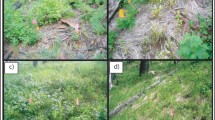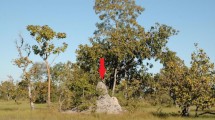Abstract
The effects of fire season on forb diversity patterns, density, and composition were determined for a northern Mixed Prairie site, USA. Repeated spring burns (dormant season), summer burns, fall burns (dormant season), and unburned treatments were compared over a 3-yr period characterized by wet and dry moisture conditions. Alpha and beta diversity were highest on unburned and summer burn treatments, while landscape mosaic diversity was highest on fall burns. Forb density was highest on fall and spring burn sites. Nine forb species comprised 82% of total densities and were significantly affected by fire season and year to year variations in moisture. Forb composition for unburned and spring burn treatments was similar, but both treatments were different from the summer burn and fall burn treatments which were similar to each other. Fire alone did not appear to be an intense enough disturbance to initiate drastic changes in the forb component of vegetation patches. Specific fire seasons did appear to either mask or enhance forb structure arising from other disturbance(s). Fire season also affected the scales of forb organization in the landscape. Contrasting spatial characteristics of the forb component of prairie plant communities may provide a diagnostic technique for exposing the interaction of disturbances at different temporal and spatial scales.
Similar content being viewed by others
References
Adams D. E., Anderson R. E. & Collins S. L. 1982. Differential response of woody and herbaceous species to summer and winter burning in an Oklahoma grassland. Southw. Nat. 27: 55–61.
Anderson K. L., Smith E. F. & Owensby C. E. 1970. Burning bluestem. J. Range Manage. 23: 81–92.
Anderson R. C. 1982. An evolutionary model summarizing the roles of fire, climate, and grazing animals and the origin and maintenance of grasslands: an end paper. pp. 297–308. In: Ester J. R. Tyrl R. J. & Brunker J. N. (eds), Grasses and grasslands: systematics and ecology. Univ. of Oklahoma Press, Norman, OK
Bakker J. P., deLeeuw J. & vanWieren S. E. 1983. Micropatterns in grassland vegetation created and sustained by sheep grazing. Vegetatio 55: 153–161.
Barbour, M. G., Burk, J. H. & Pitts, W. D. 1980. Terrestrial plant ecology. The Benjamin/Cunning Publishing Company, Inc. pp. 139–140
Barnes P. W., Tieszen L. L. & Ode D. J. 1983. Distribution, production and diversity of C3-and C4 dominated communities in a mixed prairie. Can. J. Bot. 761–751.
Biondini M. E., Mielke P. W. & Berry K. J. 1988. Datadependent permutation techniques for the analysis of ecological data. Vegetatio 75: 161–168.
Bloomfield P. & Steiger W. L. 1980. SIAM Journal on scientific and statistical computing. Vol. 1, pp. 240–301.
Christensen, C. 1977. Geology and water resources of McPherson, Edmunds and Faulk counties, South Dakota. Part I. Geology. South Dakota Geol. Surv. Bull.
Coffin D. P. & Lauenroth W. K. 1988. The effect of disturbance size and frequency on a shortgrass plant community. Ecology 69: 1609–1617.
Collins B. S., Dunne K. P. & Pickett S. T. A. 1985. Responses of forest herbs to canopy gaps. pp. 218–234. In: Pickett S. T. A. & White P. J. (eds), Ecology of natural disturbances and patch dynamics. Academic Press: Orlando, Florida.
Collins S. L. & Barber S. C. 1985. Effects of disturbance on diversity in mixed-grass prairie. Vegetatio 64: 87–94.
Collins S. L. 1987. Interaction of disturbances in tallgrass prairie: a field experiment. Ecology 68: 1243–1250.
Gibson D. J. & Hulbert L. C. 1987. Effect of fire, topography and year-to-year climatic variation on species composition in tallgrass prairie. Vegetatio 72: 175–185.
Gibson D. J. 1988. Regeneration and fluctuation of tallgrass prairie vegetation in response to burning frequency. Bull. Torrey Bot. Club. 115: 1–12.
Gleason H. A. 1926. The individualistic concept of plant association. Bull. Torrey Bot. Club. 53: 1–20.
Henderson, R. A. 1981. The response of forb species to seasonal timing of prescribed burns in remnant Wisconsin prairie. M.S Thesis. University of Wisconsin, Madison, USA
Higgins, K. F. 1986. Interpretation and compendium of historical fire accounts in the Northern Great Plains. USDI Fish and Wildlife Serv. Res. Pub. 161
Hill M. O. 1979. DECORANA — a Fortran program for detrended correspondence analysis and reciprocal averaging. Ecology and Systematics, Cornell University, Ithaca, New York, USA.
Hill M. O. & GauchJr. H. 1980. Detrended correspondence analysis: an improved ordination technique. Vegetatio 42: 47–58.
Hobbs R. J. & Mooney H. A. 1985. Community and population dynamics of serpentine grassland annuals in relation to gopher disturbance. Oecologia (Berlin) 67: 342–351.
Huston M. 1979. A general hypothesis of species diversity. American Naturalist. 113: 81–101.
Istock C. A. & Scheiner S. M. 1987. Affinities and highorder diversity within landscape mosaics. Evolutionary Ecology 1: 11–29.
Kruger F. J. 1984. Effects of fire on vegetation structure and dynamics. pp. 219–244. In: Booysen P. de V. & Taintou N. M. (eds), Ecological effects of fire in South African ecosystems. Springer-Verlag, N.Y.
Laycock W. A. 1958. The initial pattern of revegetation of pocket gopher mounds. Ecology 39: 346–351.
Loucks O. L., Plumb-Mentjes M. L. & Rogers D. 1985. Gap processes and large-scale disturbances in sand prairies. pp. 71–83 In: Pickett S. T. A. & White P. J. (eds), The ecology of natural disturbance and patch dynamics. Academic Press, Inc. N.Y., USA.
Lovell, S. L., Henderson, R. A. & Howell, E. A. 1982. The response of forb species to seasonal timing of prescribed burns in remnant Wisconsin prairies. pp. 11–15. In: Proc. of the 8th North American Prairie Conference.
McConnaughay K. D. & Bazzaz F. A. 1987. The relationship between gap size and performance of several colonizing annuals. Ecology 68: 411–416.
Miller T. E. 1982. Community diversity and interactions between the size and frequency of disturbance. Am. Nat. 120: 533–536.
Moore C. T. 1972. Man and fire in the Central North America grassland 1535–1890: a documentary historical geography. Ph.D. Thesis. Univ. of California, Los Angeles, USA.
Mosteller F. & Rourke R. E. K. 1973. Sturdy statistics. Addison-Wesley, Reading, MA, USA.
Nelson J. G. & England R. E. 1971. Some comments on the causes and effects of fire in the northern grassland area of Canada and the nearby United States, circa 1750–1900. Canada Geogr. 15: 295–306.
Ode D. J., Tieszen L. L. & Lerman J. C. 1980. The seasonal contribution of C3 and C4 plant species to primary production in a Mixed Prairie. Ecology 61: 1304–1311.
Phillips P. 1936. The distribution of rodents in overgrazed and normal grasslands of central Oklahoma. Ecology 17(4): 673–679.
Platt W. J. 1975. The colonization and formation of equilibrium plant species associations of badger disturbances in tallgrass prairie. Ecol. Monogr. 45: 285–305.
Scheiner S. M. & Istock C. A. 1987. Affinity analysis: methodologies and statistical inference. Vegetatio 72: 84–93.
Shannon C. E. & Weaver W. 1973. Mathematical theory of communication. university of Illinois Press, Urbana, USA.
Snedecor, G. W. & Cochran, W. G. 1967. Statistical methods. The lowa State University Press. pp. 325–327.
Spencer S. R., Cameron G..N., Eshelman B. D., Cooper L. C. & Williams L. R. 1985. Influence of pocket gopher mounds on a Texas coastal prairie. Oecologia (Berlin) 66: 111–115.
Steuter A. A. 1986. C3/C4 production shift on seasonal burns — northern mixed prairie. J. Range Manage. 40: 27–31.
Steuter A. A. 1986. Fire behavior and standing crop characteristics on repeated seasonal burns — northern mixed prairie, pp. 54–59. In: Koonce A. L. (ed.), Prescribed burning in the Midwest — state of the art symposium. Univ. Wisconsin, Stevens Point, USA.
Tilman D. 1982. Resource competition and community structure. Princeton University Press, Princeton, New Jersey, USA.
Vogel R. J. 1974. Effect of fire on grasslands. In: Kozlowski T. T. & Ahlgren C. E. (eds), Fire and ecosystems pp. 139–194. Academic Press, New York, N.Y.
Wells P. V. 1965. Scarp woodlands, transported soils and the concept of grassland climate in the great plains region. Science 148: 246–249.
Wells P. V. 1970. Postglacial vegetation history of the great plains. Science 167: 1574–1582.
Wright H. A. & Bailey A. W. 1982. Fire ecology: United States and Canada. John Wiley and Sons, New York. N.Y.
Author information
Authors and Affiliations
Rights and permissions
About this article
Cite this article
Biondini, M.E., Steuter, A.A. & Grygiel, C.E. Seasonal fire effects on the diversity patterns, spatial distribution and community structure of forbs in the Northern Mixed Prairie, USA. Vegetatio 85, 21–31 (1989). https://doi.org/10.1007/BF00042252
Accepted:
Issue Date:
DOI: https://doi.org/10.1007/BF00042252




